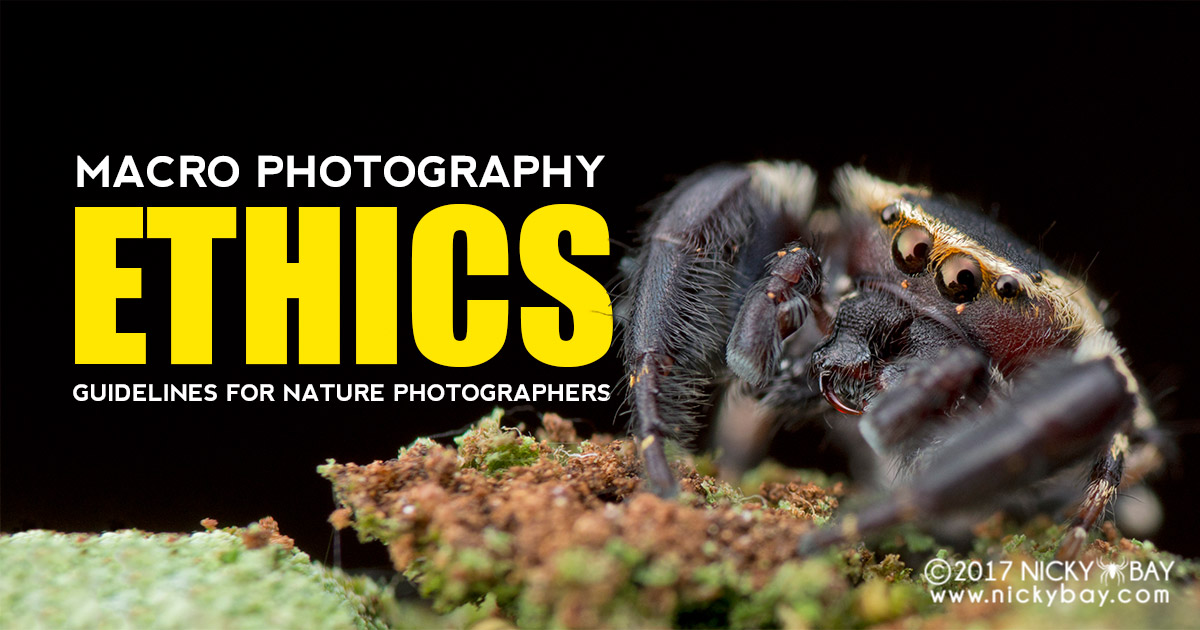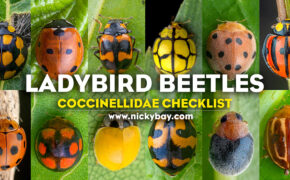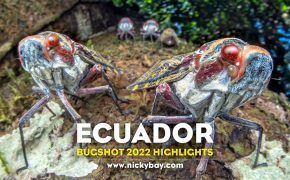As a macro photographer, one would undoubtedly face the issue of ethics and responsibility in the field. I will explain more about this, as well as my personal views on this page. Hopefully, this will allow more macro photographers to understand the importance of good ethics, and exercise good individual judgment about ethical and responsible behaviour in the field. This is a must-read for anyone starting out on nature macro photography.
At some points of time in my macro journey, I have broken many of these guidelines myself and have come to regret the actions. In fact, many are written here today because of the personal experiences that I have had with them. Even my earlier macro workshops allowed participants to practise on subjects in captivity in the conservatory, where the handling was inappropriate. I am learning the importance of these mistakes through the hard way. I hope other macro photographers do not repeat the same mistakes and learn to make better judgment calls when out in the field.
Welfare of Subjects
-
Touching subjects with prey
In the wild, many living things only eat once in many days. Some spiders have to use up a lot of silk just to get 1 prey. Be mindful that touching these subjects or stressing them may lead them to drop their precious prey and essential food for the week.
-
Handling subjects with your hand
It requires many years of training to be able to exert the precise force in handling any tiny subject without causing any injury or death. Attempting to handle them directly is strongly discouraged. It is NATURAL for subjects to run about. Forcefully holding a subject’s leg to prevent it from moving can lead to permanent injuries to the subject. While most beetles have hardened elytra on their backs, they have claws on their legs to help them cling on tightly to wherever they stand. Avoid picking them up forcefully as their leg claws will cling on tight with no way of letting go and can get damaged in the process.
-
Displacing subjects
Refrain from putting subjects in unnatural environments just to take a good photo. There are exceptions, so do exercise good judgment on this. If any subject is displaced from its natural habitat due to your presence, it will be your obligation to return it to its original position. Failure to do so may lead to the death of the subject, especially those who rely only on their host plants for survival. A photo showing a different habitat from its original will also confuse biologists who are studying them, and the displacement can be easily exposed by experts.
On this note, I do displace some subjects for photography before returning them to their original locations, although I try to avoid doing so. One very practical reason is that the subjects will usually be more skittish once displaced, making them much more difficult to photograph.
-
Collecting subjects
Refrain from collecting subjects home or away from their habitat purely for the sake of photography. Some people do that to shoot in a studio environment. It can mean certain death for the subjects unless you are a proficient caretaker of that species. The only exception to this is for specific scientific reasons when you are an entomologist or working for one. Many may wonder why entomologists need to collect and kill specimens. This has been explained in detail by Piotr Naskrecki in his blog post Involuntary Bioslaughter and Why a Spider is Dead, as well as in the Ask an Entomologist blog.
-
Excessive exposure to ultraviolet
When practicing any form of ultraviolet (UV) photography, be aware that prolonged exposure to UV may harm both the human and the subjects. Refrain from pointing the UV light source into any eyes, and keep the exposure period to a minimum.
-
Exposing subjects to artificial elements
Some photographers choose to create artificial scenes to make the photo unique. I personally avoid such methods because of the stress and potential injury imposed on the subjects. On top of that, because the scenes are artificial, it will most likely mislead others to think that such a scene is possible in nature. Some of the methods are listed here as examples, but the list is definitely not limited to this. Before praising the photographers for their artistry, please consider how the shots were made.
- Artificially placing 2 or more subjects together
- Placing a droplet of water on a jumping spider (come on…)
- Exposing terrestrial subjects to water mass to create reflections and additional drama (e.g. terrestrial snails) – some subjects are not meant to be in water masses and can drown in the process
- Forcing subjects into unnatural poses, sometimes using strings or wires to control the subjects like a puppet
- Gluing or clamping subjects in place to stop them from moving
- Refrigerating subjects so that they are temporarily paralyzed – can be done safely, but this can easily cause tissue damage and death under inexperienced hands
- Shaking subjects in a container to make them “dizzy”
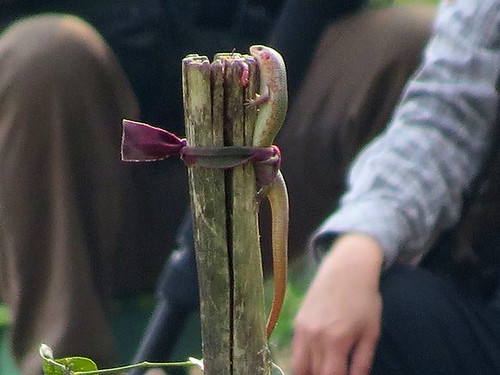
Example of unethical photography with a skink tied up.
Image courtesy of Rick Lee, who caught the photographers in the act.
Note: This photo is NOT from Indonesia. Staged nature photography occurs in many countries and we should not label a single nation’s photographers for the acts of some.
This is a very contentious topic. The images may look spectacular with such manipulation, and you may get lots of “likes” and “shares” on social media platforms. However, I do not find this to be worth imposing the subjects to what I term the above as torture. There is nothing natural about it and cannot be deemed to be “nature photography“. To the general public: Before you decide to share such “art” in the future, consider what went on behind the scenes. Nature macro photography is about bringing the beauty of nature to the viewer, let’s just stick to that, shall we? 🙂
While I avoid the unethical methods and examples above, I am not specifically against staged photography. Staged photography is possible without adopting the use of unethical practices stated above. The problem with many instances of staged photography is that the scenes are obviously biologically impossible and many of them are likely to have been stressed or even tortured into the depicted scenes. Where possible, I would personally prefer to shoot subjects in situ as they provide much more valuable scientific information when presented in its natural state.
-
Appreciate all life forms
Not exactly related to ethics, but a good habit to inculcate. Learn to appreciate every life form with equal importance. A simple common cricket or ant can be shot beautifully too. What appears to be a common subject to you, might just turn out to be new to science!
-
Learn to stop
Recognize when a subject is completely stressed out and time for you to stop trying to coax it into position to get the perfect shot.
Conservation of Habitat
-
Habitat damage
Refrain from cutting/plucking any leaf. Leave your scissors at home where they belong. A solitary leaf could be the essential cover for an insect against predators. I used to think that cutting a random leaf in a jungle causes no harm, but I have witnessed examples where bug nests were exposed and invaded by predators after some leaves were conveniently cut just because they were “blocking the view”. It caused the death of entire families. This also applies to peeling of tree bark to expose certain subjects, and lifting of rocks (which should be put back in place). Again, not a hard and fast rule, please exercise good judgment on this.
-
Publicising photos of rare subjects
Before posting photos of the rare subject that you have just shot, stop and consider the potential impact on the creature’s habitat. Poachers may get excited upon seeing your photos and go on hunts to the common spots to collect the subjects for sale. Eager macro photographers may also come in hordes to photograph the subjects. Once, photos and location of some rare bugs were posted and shared, and it led to many shooters “invading” the area in large numbers. The area was actually a farm, and the macro shooters flattened the crops. Eventually, angry farmers decided to uproot the host plant altogether to stop the unwelcome crowd.
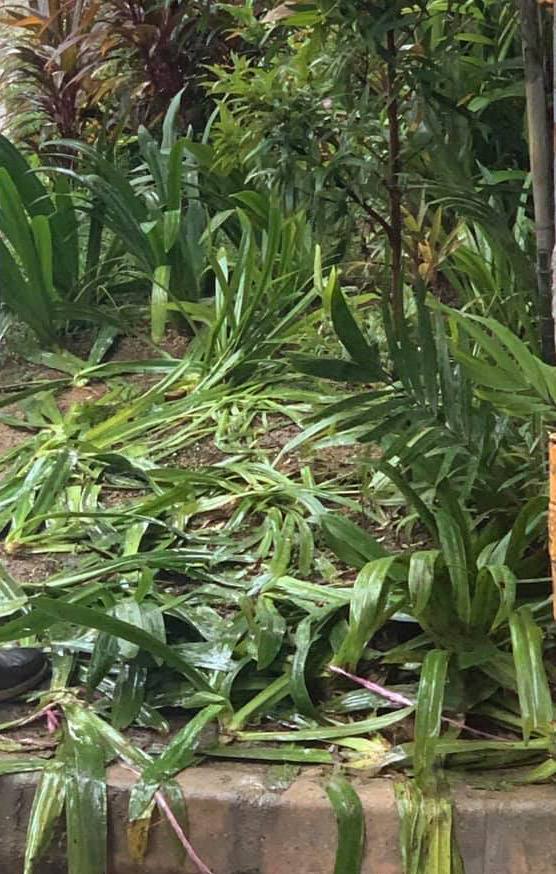
Example of flattened vegetation due to large groups of inconsiderate photographers.
Image courtesy of Girish Jamadagni. -
Publicising locations
Other than the obvious reasons stated in the previous point, this is especially important for places outside of Singapore. Never reveal exact locations as they are usually very remote and may attract robbers to stalk you or your group. Expensive camera equipment is a big lure and photographers are at risk in remote locations.
-
Littering
As obvious as it sounds, take nothing but photographs and videos, leave nothing but footprints.
Personal Conduct
-
Shooting priority
As a general rule, the one who finds the subject gets to shoot it first. If you are not part of the group, it is basic courtesy to ask before joining in to shoot.
-
Queuing to shoot
In a group, it is common to find a subject and have everyone take turns to shoot. Use some common sense and do not go straight to maximum magnification and potentially chase the bug away, ruining the chance for others to shoot. You can always “re-queue” and shoot at higher magnification later.
-
Obstruction
When someone else is shooting, do not obstruct their view and do not stand behind the subject as you may appear in the photo’s background.
-
Stand downstream
When others are shooting subjects under the water, such as a stream or shore during low tide, never stand upstream. Doing so will kick up murky water to where the subjects are.
-
Disturbance
Noise and sudden movement can scare away skittish bugs. Watch where you step and be quiet when others are shooting.
-
Smoking
Refrain from smoking during any field trip. If you really have to smoke, move far away from the others in the group, especially when they are photographing something and already out of breath.
-
Red-face test
If you find yourself embarrassed or uncomfortable when questioned about something you are doing, you probably should not do it. Of course, this does not mean that you can do whatever you want if you have a thick hide. 😉
-
Education
If you spot others engaging in any unethical acts stated above, be tactful in informing them.
Online Ethics
Sharing of photos online is commonplace. These are scenarios that one would face sooner or later, either as a photographer, website owner or internet user.
-
Subject identification and description
Adding identification and meaningful description to the subjects to our photos is great, but not when it is wrong, unverified or copied without citation.
-
Internet is unreliable
Do not wholly trust what you see on the internet. Another webpage tagging a specific ID to a photo does not mean it is correct. This includes my blog and Flickr albums as well. This is the most common way how wrong IDs are spread.
-
Identification and description credit
If you publish an ID, copy a description or derive any text from another person, website or book, please include the ID credit. Proper identification can sometimes be complicated work, so credits should be due. ID credits also allow others to follow up with discussions with the correct person who made the identification. If the identification is wrong in the first place, remember that you are taking the “credit” for the mistake too.
-
Be conservative with identification
Avoid stating the full species of any subject unless you are absolutely certain or have consulted an expert who is certain. Identification is based on a specific set of characters and NOT simply based on visual similarities on photographs. Subjects that appear “identical” in photos to an untrained eye should not be assumed to be the same species. Conversely, subjects that look radically different can actually be the same species but different gender or morph. Most scientists will refuse to identify based on a photo because they need to examine the specimen under a microscope to accurately determine the defining characters. For some subjects, it is not possible to identify them accurately without dissection or DNA analysis.
-
Include country
For the purpose of identification, including the locality of the subject is important. In most cases, including the country is essential.
-
-
Photo Authenticity
Digital manipulation is commonplace, but just how much is considered ethical?
-
Accurate representation of nature
The most important guideline for post-processing images from nature is to keep things accurate to nature. Similar rules usually apply to wildlife photography competitions.
-
Unethical manipulation
Some examples of unethical manipulation include:
- Adding or subtracting primary content
- Altering colours significantly
-
Ethical manipulation
The following manipulations can be extensive, but are generally still considered ethical. Note that nature photography competitions may have stricter rules of ethics.
- Focus stacking
- HDR images
- Photo stitching
- Noise reduction
- Sharpening
- White balance adjustment
- Cropping
-
Art vs Nature
Artistic manipulations must be differentiated clearly from nature images. Nothing wrong with such creations, but they must not mislead.
-
-
Caption Authenticity
Always be authentic in providing a caption for photos. Never lie or deceive the audience about how the shot was created. It is easy to be exposed. Read how the photo of a Frog Riding a Beetle was exposed by Truths Behind Fake Nature Photography.
-
Studio shots
If it is a dead subject or studio shot, do not proclaim that it was found and shot alive in the wild. This is especially true for many extreme magnification stacks which were done on dead subjects.
-
Artificial scenes
A nature photographer documents nature, so staging artificial scenes may present a false representation of nature. If it has to be done for art, it should be clarified that the subjects were artificially coerced into certain behavior, positions or habitats. Some scenarios are biologically impossible so fake captions and descriptions tend to fall through. Photos of artificially transported subjects may also provide false information to researchers on its natural habitat.
-
Found in the wild?
If the subject is not found in the wild but purchased or obtained via other means in captivity, state so. Many species are only recorded in certain parts of the world.
-
-
Publishing Behind the Scenes Photos
Publishing behind-the-scenes photos can be fun. It is usually interesting to see how some shots are taken, and the lengths some photographers go to get the perfect shot. However, one should be careful about making such photographs public as it can encourage copycats from the amateurs. This could range from carrying and posing with venomous subjects (usually snakes), to holding seemingly harmless subjects. Again, there is no hard and fast rule to this and one should understand the possible consequences and exercise good judgement first.
-
Image/Photo Distribution
Always assume that the photographer of any photo is the copyright owner, and that it is NOT OK to:
- Upload a copy of the image to your own website/page without explicit written permission from the owner.
- Resize, crop or manipulate the original image in any way not explicitly permitted by the owner.
- Remove or replace any existing watermarks. Handling of watermarks should only be done by the copyright owner.
What if you wish to upload a beautiful image that you found online with no watermark or hint of the owner?
-
Locate and contact the image owner
Do a reverse image search to find other sites hosting the image. READ the content of the sites to find out if they specified the owner of the image, and look for the photographer’s contact. The photographer put in a lot of effort and money to produce the image. You could easily spare a few minutes to do this. “No time” and ignorance is not an excuse.
-
Avoid incorrect credit
NEVER credit “Google Images”, image aggregators, nor any news agency. They are definitely not the owners of the images. If your credit is NOT a photographer’s name, chances are high that it is inaccurate.
-
Pass when in doubt
If in doubt, do not use the image. It does not kill you to pass up on a pretty image, but can land you in trouble should you misuse it. If you enter a store and you can’t find the store owner, does it mean that you have the right to take anything and leave? Ignorance is not a valid excuse.
Conclusion
The above-stated points are just my personal views that have “evolved” over time. I have no capacity whatsoever to dictate that this is what you should or should not do, but I hope for everyone to better understand and weigh the differences before making their own stand. I am not a purist, and there are many grey areas where I can fall into the other end of the spectrum too. It is true that we probably killed more bugs simply by stepping around in the forest or mowing the lawn as compared to any photographic incident, and that many of us still consume meat – that is why this article is focused on ethics and not practicality in numbers.
This article is not targeting those who focus on staged macro photography or high magnification macro through stacking. Though I make it clear that I do not have preference over such techniques, I also do not have anything personal against those who practise them. In fact, I help entomologists and arachnologists with photography of specimens in captivity in their labs at times, but those photos would be indicated clearly in the Flickr description.
Feedback is definitely welcome, but I recognize that this is a contentious issue and opinions are likely to differ. Hence I would like to request that everyone be respectful of others when commenting. Ultimately, you make your own choices and you draw your own line, but please make sure that they are well-informed decisions.

